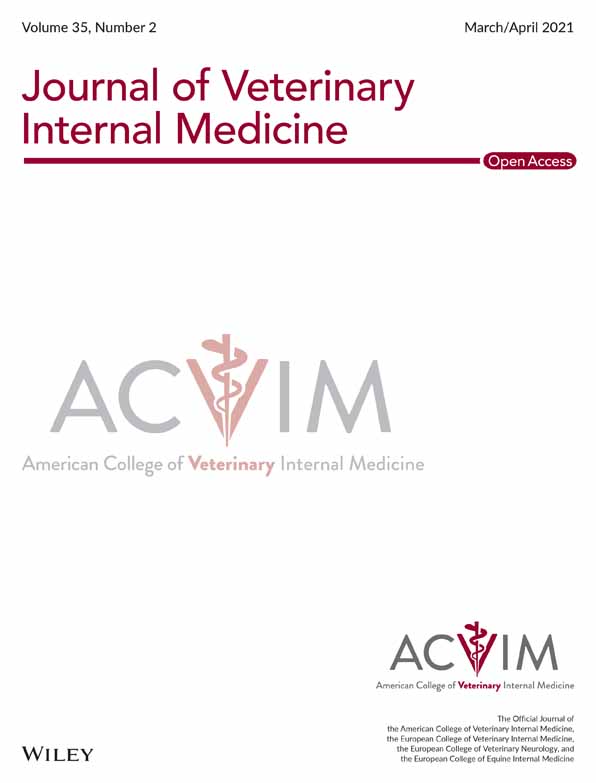Response to letter to editor regarding “Efficacy of adding ramipril (VAsotop) to the combination of furosemide (Lasix) and pimobendan (VEtmedin) in dogs with mitral valve degeneration: The VALVE trial”
We appreciate the interest expressed in our VALVE trial by Dr Oyama and colleagues, and we would like to take the opportunity to discuss the various points raised.
In response to the question about the variables' magnitude of effect and confidence intervals, we are happy to provide the results of the univariate and multivariate analyses in Tables 1 and 2 (these data had not been included in the paper due to word count restrictions; see editor's note).
| Variable | HR | CI lower | CI upper | P value |
|---|---|---|---|---|
| Creatinine | 1.00 | 1.00 | 1.01 | .11 |
| LA/Ao | 0.96 | 0.71 | 1.30 | .8 |
| LVIDs inc | 1.01 | 0.99 | 1.02 | .36 |
| VHS score | 1.20 | 0.97 | 1.49 | .1 |
| Exercise | 1.10 | 0.84 | 1.45 | .48 |
| Furosemide dose | 1.01 | 0.97 | 1.05 | .69 |
| CKCS | 0.55 | 0.24 | 1.26 | .16 |
| Dual therapy | 0.81 | 0.58 | 1.12 | .21 |
| Variable | HR | CI lower | CI upper | P value |
|---|---|---|---|---|
| Creatinine | 1.00 | 1.00 | 1.01 | .2 |
| LA/Ao | 0.93 | 0.65 | 1.31 | .67 |
| LVIDs inc | 0.99 | 0.96 | 1.03 | .65 |
| VHS score | 1.10 | 0.87 | 1.38 | .42 |
| Exercise | 1.12 | 0.86 | 1.46 | .41 |
| Furosemide dose | 1.00 | 0.95 | 1.05 | .97 |
| CKCS | 0.59 | 0.25 | 1.43 | .24 |
| Dual therapy | 0.84 | 0.59 | 1.19 | .32 |
Concerning the starting dose of furosemide in the VALVE trial, the authors agree that this dosage was quite high. However, it is common practice in our clinics to titrate the furosemide down to the minimal effective dose. The patients are discharged often after stabilization at the clinic at an initially high diuretic dose, in order to prevent immediate relapse of clinical signs soon after discharge, which might lead to owner disappointment and potential decision for euthanasia. If a dog has been stable at home for 3 days, and the owners feel comfortable counting the resting respiration rate, we start to decrease the diuretic dose. We analyzed the furosemide dosages at the first and second recheck examinations. The mean furosemide dosage for both groups at day 7 was 5.91 mg/kg/d (dual therapy [DT], 5.89 mg/kg/d; triple therapy [TT], 5.91 mg/kg/d). After 1 month, the mean furosemide dosage for all dogs was 5.32 mg/kg/d (DT, 4.78 mg/kg/d; TT, 5.80 mg/kg/d). These diuretic dosages were similar to those used in the QUEST study.
We looked at the additionally prescribed drugs not only at the entry date, which we reported in our article, but throughout the study. A total of 61 dogs had received spironolactone during the course of the study (32 dogs in the DT group and 29 dogs in the TT group) and there was no significant difference between the groups. Seven dogs had received hydrochlorothiazide.
Regarding the question about adverse effects, in 39 dogs, adverse effects were reported at least once, and some dogs had several adverse effects recorded. Most adverse effects were related to pre-renal azotemia, which occurred most commonly at the beginning of the study, during the period of titrating the dogs down to the minimal effective dose of diuretic. In some dogs, azotemia occurred later in the study, as the disease progressed. In these dogs, the furosemide dose had already been titrated to the minimal effective dose to avoid pulmonary edema and, as such, it was not decreased any further. In other words, these dogs remained on the prescribed diuretic dose despite azotemia. However, none of these dogs was excluded from the study, died or was euthanized because of azotemia.
Other adverse effects, which we reported, included gastrointestinal signs, syncope, weakness, and sudden cardiac death.
The study was conducted according to good clinical practice protocols, including regular monitoring visits and reporting of adverse effects and it was conducted in the same manner as the QUEST trial. Independent data auditing was performed by the Stablab statistical unit of the Ludwig-Maximilian University Munich, and this unit was neither sponsored nor otherwise involved in the clinical trial.
Editor's note: Please note that, according to published author guidelines for all types of manuscripts published in the Journal, word count includes text starting at the beginning of the introduction and ending at the end of the discussion; it does not include title page, abstract, references, tables or figure legends.




